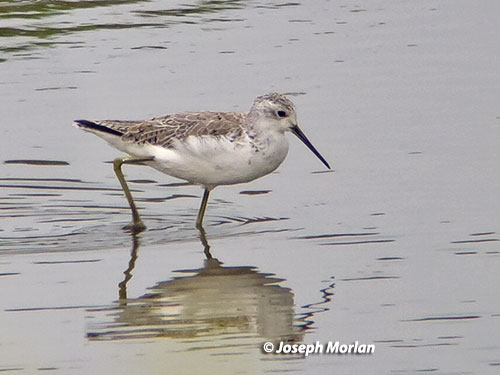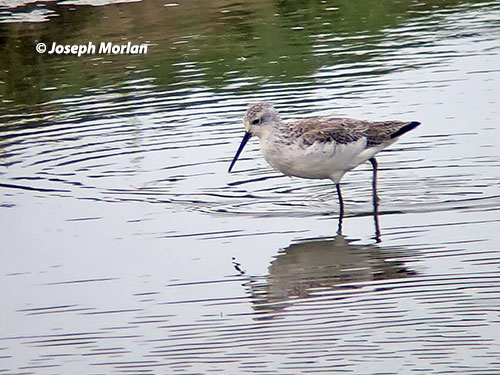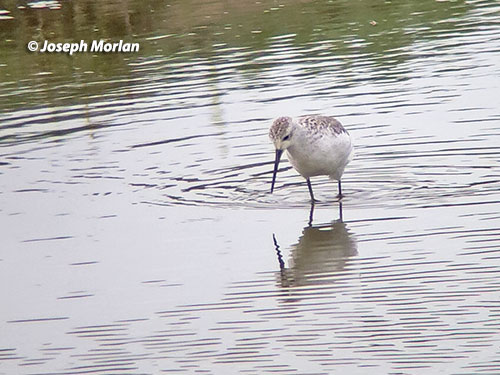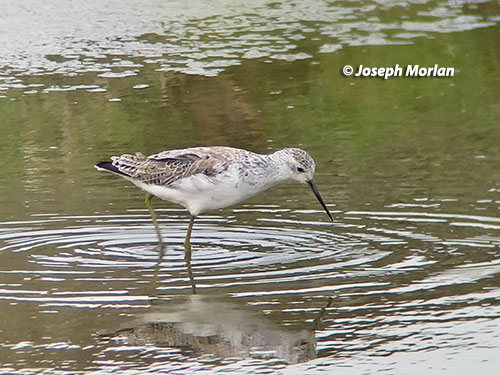Liberty Island Road and Malcolm Lane, Dixon, Solano County, CA
11 April 2014
Joseph Morlan
Photos © 11 April 2014 by Joseph Morlan. All rights reserved. Click here for higher resolution images.

Marsh Sandpiper (Tringa stagnatilis)
Liberty Island Road and Malcolm Lane, Dixon, Solano County, CA
11 April 2014
Joseph Morlan
Photos © 11 April 2014 by Joseph Morlan. All rights reserved. Click here for higher resolution images. 
This bird was found by Roger Muscat and confirmed and photographed by John Sterling on the evening of 9 April 2014. The next day it was seen again early in the morning and late in the evening but was missed most of the day when I was there. On 11 April, Robbie Fischer and I decided to try for a late afternoon appearance. We did not arrive until about 5:15pm.
Upon arrival, we parked at the corner where we met Joan Humphrey who was just leaving. She advised us that the Marsh Sandpiper was being very cooperative about 100 yards to the east where a line of birders were positioned on the road looking into the tidal ditch on the north side of the road. We quickly saw the Marsh Sandpiper foraging near an irrigation outlet pipe. It could be easily picked out from the numerous Greater Yellowlegs (Tringa melanoleuca) by its small size and pale overall coloration. Here is the exact location.
I stationed my scope next to Jeff Seay and started attempting to digiscope the bird. As luck would have it, the bird worked its way in the channel closer and closer to us allowing for decent photos and good observation opportunities. The sky was overcast providing diffuse lighting. We continued to watch and photograph the Marsh Sandpiper until about 6:20pm at which time the wind picked up and we headed for home. Although the bird jumped and fluttered a few times during our observation, it did not fly. Instead it continued to forage actively the entire time.
It foraged with the gingerly, high-stepping gait typical of birds in the genus Tringa. It actively stabbed its long thin bill into the water sometimes submerging its entire head and bill. Other times it engaged in a back-and-forth sweeping action with its bill recalling the foraging behavior of American Avocet (Recurvirostra americana). I have never seen this particular behavior in any other species of Tringa.
 Description
Description
The following description is based on memory and on photos:
A small wader, about half the bulk of adjacent Greater Yellowlegs; it was somewhat slimmer and more delicate looking than the yellowlegs. The most noticeable feature was its overall pale gray color on its mantle and its clear white underparts imparting a ghostly-white impression. Its bill was very long and needle-like reminiscent of that of Wilson's Phalarope (Phalaropus tricolor). In fact its tripping gait also suggested the exaggerated movements of Wilson's Phalaropes when feeding on shore.
The crown was pale gray with dark gray spots and streaks starting above the eye and terminating at the nape. The forehead, lower cheek, malar and throat were entirely white contrasting with the black eye. Faint gray smudging behind the eye was separated from the gray cap by a white eyebrow extending behind the eye but not in front of it.
The back was pale gray and appeared to contain two different types of feathers. Most of the back and scapular feathers were solidly pale gray, with off-white fringes. These feathers were basic-like, but appeared to be fresh, not worn. The scapulars, wing coverts and tertials were gray centered but had faint gray or blackish cross bars. These feathers were alternate-like and also appeared to be fresh, not worn. The primaries were black, visible just below the folded tertials, but otherwise primary projection was very short.
The underparts were solid white except for patches of darker gray spotting on the side of the neck extending to the side of the breast. The legs and feet were olive-yellow. This color was visible only in good light. Under most light conditions the legs appeared brownish. The toes were seen to be unlobed when the feet were lifted out of the water.
The tail was seen briefly when the bird fluttered and appeared to be white with some undefined grayish markings. The bird never flew so I did not see the white dowitcher-like wedge up the back, but that feature is visible in flight shot photos taken by others. During our observation I did not knowingly hear the bird call.
 Identification
Identification
Although this is a distinctive species, there are several other American waders with which it may be confused. However none of these have the white wedge up the back of Marsh Sandpiper.

Discussion
This species was added to the state list when the California Bird Records Committee (CBRC) approved a record of an individual seen and photographed at the north end of the Salton Sea near Mecca, Riverside County on 26 October 2013 (CBRC record #2013-192). The only other previous record south of Alaska is of one photographed 12 October 2011 at Punta Banda, Ensenada, Baja, Mexico (photo). In Alaska there have been at least 8 individuals, all young birds in Fall (Howell et al. 2014). The current record appears to be the first Spring record for the New World.
Aging
Peter Pyle has analyzed an apparent eccentric wing molt in flight photos and judged that it is a young bird (SY) hatched in 2013. He writes, "p6-p10 and the inner 6-8 secondaries have been replaced and contrast with the older and more worn p1-p5 and 7-8 outer secondaries.....the primary limit is best seen at Dan Brown's photo here. Being first-cycle also explains the anemic alternate plumage at this date; adults should be in full alternate by now according to BWP."
Reference
Howell, Steve N. G., Ian Lewington, and Will Russell. 2014. Rare Birds of North America: Princeton UP.
This rarity has generated considerable interest with many photos on the internet. Some external links follow: